
General surgery is a surgical specialty that focuses on abdominal contents including esophagus, stomach, small bowel, colon, liver, pancreas, gallbladder, appendix and bile ducts, and often the thyroid gland. They also deal with diseases involving the skin, breast, soft tissue, trauma, peripheral vascular surgery and hernias and perform endoscopic procedures such as gastroscopy and colonoscopy.
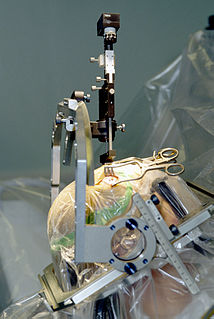
Neurosurgery, or neurological surgery, is the medical specialty concerned with the prevention, diagnosis, surgical treatment, and rehabilitation of disorders which affect any portion of the nervous system including the brain, spinal cord, peripheral nerves, and extra-cranial cerebrovascular system.

Urology, also known as genitourinary surgery, is the branch of medicine that focuses on surgical and medical diseases of the male and female urinary-tract system and the male reproductive organs. Organs under the domain of urology include the kidneys, adrenal glands, ureters, urinary bladder, urethra, and the male reproductive organs.

Mastectomy is the medical term for the surgical removal of one or both breasts, partially or completely.

Bladder cancer is any of several types of cancer arising from the tissues of the urinary bladder. It is a disease in which cells grow abnormally and have the potential to spread to other parts of the body. Symptoms include blood in the urine, pain with urination, and low back pain.
Andrology is the medical specialty that deals with male health, particularly relating to the problems of the male reproductive system and urological problems that are unique to men. It is the counterpart to gynaecology, which deals with medical issues which are specific to female health, especially reproductive and urologic health.
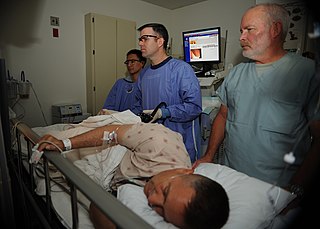
Colonoscopy or coloscopy is the endoscopic examination of the large bowel and the distal part of the small bowel with a CCD camera or a fiber optic camera on a flexible tube passed through the anus. It can provide a visual diagnosis and grants the opportunity for biopsy or removal of suspected colorectal cancer lesions. Colonoscopy can remove polyps as small as one millimeter or less. Once polyps are removed, they can be studied with the aid of a microscope to determine if they are precancerous or not. It can take up to 15 years for a polyp to turn cancerous.

A biopsy is a medical test commonly performed by a surgeon, interventional radiologist, or an interventional cardiologist involving extraction of sample cells or tissues for examination to determine the presence or extent of a disease. The tissue is generally examined under a microscope by a pathologist, and can also be analyzed chemically. When an entire lump or suspicious area is removed, the procedure is called an excisional biopsy. An incisional biopsy or core biopsy samples a portion of the abnormal tissue without attempting to remove the entire lesion or tumor. When a sample of tissue or fluid is removed with a needle in such a way that cells are removed without preserving the histological architecture of the tissue cells, the procedure is called a needle aspiration biopsy. Biopsies are most commonly performed for insight into possible cancerous and inflammatory conditions.
Cordotomy is a surgical procedure that disables selected pain-conducting tracts in the spinal cord, in order to achieve loss of pain and temperature perception. This procedure is commonly performed on patients experiencing severe pain due to cancer or other incurable diseases. Anterolateral cordotomy is effective for relieving unilateral, somatic pain while bilateral cordotomies may be required for visceral or bilateral pain.
Surgical oncology is the branch of surgery applied to oncology; it focuses on the surgical management of tumors, especially cancerous tumors.
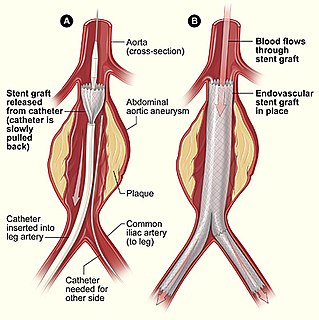
Minimally invasive procedures encompass surgical techniques that limit the size of incisions needed and so lessen wound healing time, associated pain and risk of infection. Surgery by definition is invasive and many operations requiring incisions of some size are referred to as open surgery, in which incisions made can sometimes leave large wounds that are painful and take a long time to heal. Minimally invasive procedures have been enabled by the advance of various medical technologies. An endovascular aneurysm repair as an example of minimally invasive surgery is much less invasive in that it involves much smaller incisions than the corresponding open surgery procedure of open aortic surgery. This minimally invasive surgery became the most common method of repairing abdominal aortic aneurysms in 2003 in the United States.

Salpingectomy refers to the surgical removal of a Fallopian tube. This may be done to treat an ectopic pregnancy or cancer, to prevent cancer, or as a form of contraception.
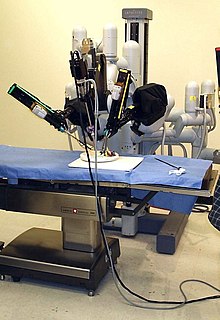
Robotic surgery are types of surgical procedures that are done using robotic systems. Robotically-assisted surgery was developed to try to overcome the limitations of pre-existing minimally-invasive surgical procedures and to enhance the capabilities of surgeons performing open surgery.

Radiofrequency ablation (RFA) is a medical procedure in which part of the electrical conduction system of the heart, tumor or other dysfunctional tissue is ablated using the heat generated from medium frequency alternating current. RFA is generally conducted in the outpatient setting, using either local anesthetics or conscious sedation anesthesia. When it is delivered via catheter, it is called radiofrequency catheter ablation.

Veterinary surgery is surgery performed on animals by veterinarians, whereby the procedures fall into three broad categories: orthopaedics, soft tissue surgery, and neurosurgery. Advanced surgical procedures such as joint replacement, fracture repair, stabilization of cranial cruciate ligament deficiency, oncologic (cancer) surgery, herniated disc treatment, complicated gastrointestinal or urogenital procedures, kidney transplant, skin grafts, complicated wound management, minimally invasive procedures are performed by veterinary surgeons. Most general practice veterinarians perform routine surgery [neuters, minor mass excisions, etc.], some also perform additional procedures.
Retroperitoneal lymph node dissection (RPLND) is a surgical procedure to remove abdominal lymph nodes. It is used to treat testicular cancer, as well as to help establish the exact stage and type of the cancer.
Neoadjuvant therapy is the administration of therapeutic agents before a main treatment. One example is neoadjuvant hormone therapy prior to radical radiotherapy for adenocarcinoma of the prostate. Neoadjuvant therapy aims to reduce the size or extent of the cancer before using radical treatment intervention, thus both making procedures easier and more likely to succeed and reducing the consequences of a more extensive treatment technique, which would be required if the tumor were not reduced in size or extent.

The Vattikuti Urology Institute (VUI) at the Henry Ford Hospital in Detroit, Michigan is a clinical and research center for urological care. The VUI is notable for being the first institute to establish robotic surgery as a treatment for patients with prostate cancer. To date, the VUI has performed more than 5,000 robotic procedures. The institute currently has 110 regular staff members, 19 full-time senior staff members, 14 clinical staff members and 5 full-time Ph.D scientists. Ranked consistently high by U.S. News and World Report, VUI is also one of the largest and most active urology departments in the United States, with nearly 50,000 patients annually from all 50 states and nearly 25 countries.
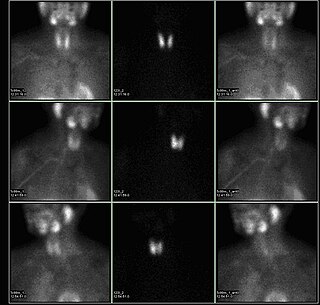
A sestamibi parathyroid scan is a procedure in nuclear medicine which is performed to localize parathyroid adenoma, which causes Hyperparathyroidism. Adequate localization of parathyroid adenoma allows the surgeon to use a minimally invasive surgical approach.















